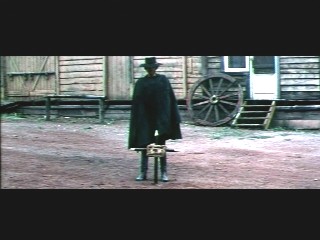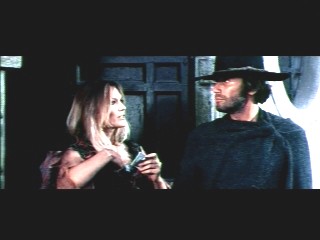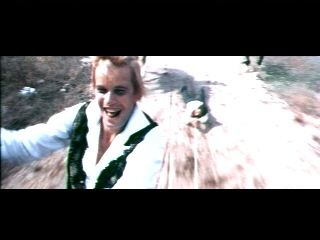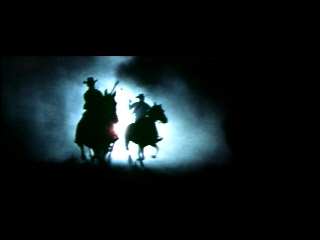
|
|
|
|
|
|
|
|
|
|
|
|
||||||||||||||
|
(a.k.a. The Strangers Gundown & Django The Bastard) (1969) Director: Sergio Garrone
Ahh, those Italians. They know a good idea when they see one. They also know that American films are filled with ideas that are often very successful in drawing an audience. So they often rip off those American films. When Dirty Harry became a success, it spawned a wave of Italian tough-cop films like The Violent Professionals and Strange Shadows In An Empty Room. Several years later, after Star Wars was released, those Italians felt "inspired" enough to make their own space epics, even if their budgets didn't quite match those of the real deal. This resulted in some of the most hilariously bad Italian genre movies of all time - check out Starcrash and The Humanoid to see what I mean. Actually, when it came to "inspiration" or simply blatant ripping things off, Italians seemed most prolific when it came to their own. For example, when the Steve Reeves Hercules proved a major success around the world, Italian filmmakers cranked out dozens more such he-man and sword-and-sandal movies, with certain elements of these movies coming up again and again. Not long afterwards, the pairing of Terence Hill and Bud Spencer in They Call Me Trinity brought in big bucks, not only were Hill and Spencer paired up again and again in the years that followed, some Italian filmmakers used other actors (like Paul Smith of Popeye fame) to make a number of Hill/Spencer imitations. All the stealing and imitation in those two genres,
however, nowhere matches what went on during the ten or so years of the
spaghetti western There were a few "Django" movies that did make some kind of effort to connect with the original. One example was with Viva Django; Terence Hill not only played a character named Django, but wore heavy black clothes like the original Django, and also did some business with a machine gun dug up from a coffin. Though most Django imitators didn't go to that much trouble, settling mostly for a few minor similarities at most. Which brings us to this week's movie, The Stranger's Gundown, better known in Europe as Django The Bastard. Spaghetti western star Anthony Steffen plays the lead character, one that does have more similarity to the original Django than in other Django movies. (Note: I am sick of typing "Django"!) Not only does his character have... that name... but he is dressed in heavy black clothing like the real McCoy. But if you look closer, you can see other features that are alike in both movies. Both characters walk into a situation where there's a great injustice in action, and get involved in this situation so they can turn things around. And there is something supernatural about both characters. Franco Nero was more or less playing the traditional figure of Death, though there is something more mysterious about Steffen's character. Though his character has a past and a personal vendetta involved in his plans, there are hints that he's been resurrected, a "devil from hell" as he calls himself at one point. It may very well be that this character inspired the one Clint Eastwood played in High Plains Drifter. If you've seen even just a few movies that follow this
formula of a vengeance-minded There will probably be some people who attribute this to Steffen's supposedly poor acting. But in fact we get to see another side to him when his character has a flashback to that Key Incident. In that flashback, we see another side to him. Though the dubbing of the movie makes it impossible to judge the way he expresses himself, we see him making full use of his body and showing several different emotions on his face. It's quite a shock to see this previously stiff character doing so much, and it emphasizes Steffen's ability to play different types. All these touches build Steffen's character into something more than just the Silent Gunfighter type who always rides alone into the sunset at the end, one that makes you really interested in what he's going to do instead of merely how he does it. There are also some other atypical characters in the narrative, but they each feel unfinished. Rada Rassimov (Baron Blood) plays not the stereotypical good woman in a bad situation, but one who is as greedy and money-hungry as the villains, having freely associated with them for her own interests (and oddly rejoins them shortly after she's ripped off by them.). But nothing is really done with this different personality, and soon she's transformed into that Woman Who Falls For The Quiet Stranger. Rossi (a poor man's Klaus Kinski) plays The Insane Brother Who Shoots Reprimanding Sheriffs, though not so one note. There's one eavesdropping scene where he's clearly embarrassed and shocked to find out Rassimov's character married him just for the money. Later, there's the beginning of a subplot where he seems to be trying to do better, by making his own (peaceful) plans to get the stranger to leave. But again, we have some promising things that are abandoned in short notice in order to do the Same Old Thing. The biggest disappointment is with the main adversary,
played by Paolo Gozlino. There is nothing about him that makes him an
interesting Not only do we experience unfamiliar sights, we also experience unfamiliar sounds - or rather, a lack of them. Vasili Kojucharov and Elsio Mancuso contribute a minimalist score, so that often all we hear in the background is the wind. When they do strike up the band, they leave out the typical twangs and toodle-oos found in movies like this for a sound that is much softer, using choirs and organs to hang a sombre air over everything. On a few occasions, they even use a Theremin, and its outer-worldliness sound actually fits quite well. It's a perfect match with the distressing atmosphere Sergio Garrone creates in the director's chair. Except for one throwaway line early on, there's no comic relief to lighten the mood. Even a celebration party sequence doesn't allow the audience to relax, because two men play a sick game of "chicken" with a lit piece of dynamite they keep throwing back and forth, while the gleeful onlookers take bets. Garrone also shows an extreme versatility with the camera, and he keeps introducing that "D" guy into a scene in many ways that are both inventive and even eerie. He might suddenly appear as a reflection in a water troth near some henchmen, discovered standing behind a crowd of people as it dissipates, or as solitaire-playing hands jutting barely into the frame where other henchmen are seen making plans to capture him. This seeming ability to pop out of nowhere just increases that sense of the supernatural around him. Garrone also uses various camera techniques to excellent
effect in other parts of the movie as well. When our black-clothed hero
sudden 
Check for availability on Amazon (VHS) See also: If You Meet Sartana..., Stranger's Gold, Valdez Is Coming |
 craze. The obvious
example is with A Fistful Of Dollars; it wasn't by far
the first spaghetti western, but its influence was huge. Soon we were
getting other spaghetti westerns that concerned unshaven anti-heroes
that spoke very little, wore ponchos, etc. etc. But there was another
spaghetti western that had as great an influence, maybe even more - the
Franco Nero-starring Django. The tale of a desert
drifter, the coffin he kept dragging behind him, and his machine gun
was such a gigantic hit with the public that in short order other
spaghetti western filmmakers were making their own "Django" movies,
copyright be damned. According to the Internet Movie Database, there
were well over fifty of these "Django" imitations made, from One
Damned Day At Dawn Django Meets Sartana! to Nude Django.
As you may have guessed, these movies usually had little to nothing
connecting them to the original movie. A lot of the time, the hero was
simply given the name "Django" and nothing more, this being done in the
original script or by the dubbing/subtitle team after the movie was
shipped to another European country (West Germany seems to have been
particularly crazy about Django.) Sometimes they didn't even bother to
name the hero Django, yet they placed the name in the movie title in
what was an apparently successful way to fool the public.
craze. The obvious
example is with A Fistful Of Dollars; it wasn't by far
the first spaghetti western, but its influence was huge. Soon we were
getting other spaghetti westerns that concerned unshaven anti-heroes
that spoke very little, wore ponchos, etc. etc. But there was another
spaghetti western that had as great an influence, maybe even more - the
Franco Nero-starring Django. The tale of a desert
drifter, the coffin he kept dragging behind him, and his machine gun
was such a gigantic hit with the public that in short order other
spaghetti western filmmakers were making their own "Django" movies,
copyright be damned. According to the Internet Movie Database, there
were well over fifty of these "Django" imitations made, from One
Damned Day At Dawn Django Meets Sartana! to Nude Django.
As you may have guessed, these movies usually had little to nothing
connecting them to the original movie. A lot of the time, the hero was
simply given the name "Django" and nothing more, this being done in the
original script or by the dubbing/subtitle team after the movie was
shipped to another European country (West Germany seems to have been
particularly crazy about Django.) Sometimes they didn't even bother to
name the hero Django, yet they placed the name in the movie title in
what was an apparently successful way to fool the public. stranger riding into
town, you probably know that it really doesn't matter what happened in
the past to give the character his motive is, so I won't bother getting
into it. (Not that the reason turns out to be terribly original,
anyway.) Nor do I really have to get into detail about the three
certain individuals in Desert City this stranger is set on executing -
you've probably guessed (correctly) that the individual who finds
himself the last to die on the stranger's hit list is an impossibly
rich and powerful guy who has the whole community under his thumb. All
that is pretty familiar stuff. But what you are probably not expecting
is that this tale of vengeance is constructed more as a horror movie
than a simple revenge westerner. As I mentioned earlier, there's
certainly a strong sense of the supernatural with Steffen's character,
not just with the wearing of black. His behavior doesn't seem like that
of an ordinary man. We've seen the "speak softly and carry a big gun"
cowboy before, but this one is more extreme in his attributes. He
doesn't speak only a little - he manages to say even less than that. He
doesn't merely walk slowly - there's an almost rigor mortis in his
snail strides. His unchanging facial expression doesn't suggest
toughness, instead giving an impression he's a mere shell being
controlled by some outside force. This can be seen in his body as well;
he won't make any physical movements unless he has to, and even then
will only use one of his arms if he's able to.
stranger riding into
town, you probably know that it really doesn't matter what happened in
the past to give the character his motive is, so I won't bother getting
into it. (Not that the reason turns out to be terribly original,
anyway.) Nor do I really have to get into detail about the three
certain individuals in Desert City this stranger is set on executing -
you've probably guessed (correctly) that the individual who finds
himself the last to die on the stranger's hit list is an impossibly
rich and powerful guy who has the whole community under his thumb. All
that is pretty familiar stuff. But what you are probably not expecting
is that this tale of vengeance is constructed more as a horror movie
than a simple revenge westerner. As I mentioned earlier, there's
certainly a strong sense of the supernatural with Steffen's character,
not just with the wearing of black. His behavior doesn't seem like that
of an ordinary man. We've seen the "speak softly and carry a big gun"
cowboy before, but this one is more extreme in his attributes. He
doesn't speak only a little - he manages to say even less than that. He
doesn't merely walk slowly - there's an almost rigor mortis in his
snail strides. His unchanging facial expression doesn't suggest
toughness, instead giving an impression he's a mere shell being
controlled by some outside force. This can be seen in his body as well;
he won't make any physical movements unless he has to, and even then
will only use one of his arms if he's able to.  heavy; he doesn't
look menacing, he doesn't act menacing, and he always elects to stay
home behind his desk while his boys do all his dirty work for him. But
in actual fact, these half-baked characters don't really bring down the
movie as much as you may think. I mentioned earlier that this was more
of a horror movie, and any horror aficionados will tell you that
character development can often get in the way of a good fright or
chill. Seen strictly in a horror viewpoint, The Stranger's
Gundown works pretty well. We have a central figure in play
that while certainly may be lacking in real depth, isn't any less
creepy and unnatural. The events also take place in an area that feels
odd, much different from the typical dry and dusty locations in movies
like this. We see patches of green grass, and even healthy-looking
trees. The streets of Desert City have muddy puddles, and the buildings
appear washed from a recent rainstorm. Though all this was no doubt
closer to how it was back then, it's still a little unsettling to
actually see this after the cinematic image of the west has been burned
into our minds. We can't fully prepare ourselves for what might happen,
because we are in an alien land.
heavy; he doesn't
look menacing, he doesn't act menacing, and he always elects to stay
home behind his desk while his boys do all his dirty work for him. But
in actual fact, these half-baked characters don't really bring down the
movie as much as you may think. I mentioned earlier that this was more
of a horror movie, and any horror aficionados will tell you that
character development can often get in the way of a good fright or
chill. Seen strictly in a horror viewpoint, The Stranger's
Gundown works pretty well. We have a central figure in play
that while certainly may be lacking in real depth, isn't any less
creepy and unnatural. The events also take place in an area that feels
odd, much different from the typical dry and dusty locations in movies
like this. We see patches of green grass, and even healthy-looking
trees. The streets of Desert City have muddy puddles, and the buildings
appear washed from a recent rainstorm. Though all this was no doubt
closer to how it was back then, it's still a little unsettling to
actually see this after the cinematic image of the west has been burned
into our minds. We can't fully prepare ourselves for what might happen,
because we are in an alien land. appears forth in
front of one character and starts to read out his death sentence,
Garrone keeps the camera on the frightened man but starts using crooked
camera angles, adjusts the focus, and slowly pans in and out. With our
perspective constantly changing, it gives us a taste of the uneasiness
the doomed man is feeling in this scene. Garrone also uses the camera
to emphasize violence without actually showing more violence. For
example, immediately after the first victim of the movie is shot, the
camera zooms into his stunned face, which stares unblinking at us as we
hear the remaining bullets fired by the vengeance-seeker. Then there
are some times when Garrone simply uses the camera to give us a cool
visual, like when we see silhouettes of riders racing through the mist
of the night, or when the man in black suddenly appears in a room where
behind him is an white backdrop that almost glowing with light. One
thing that even western haters will have to admit is that this guy sure
knows how to make an entrance. Appreciators of westerns will find much
more to enjoy, especially since they'll get to go down some new paths
and see some new things instead of a retread down more familiar routes.
appears forth in
front of one character and starts to read out his death sentence,
Garrone keeps the camera on the frightened man but starts using crooked
camera angles, adjusts the focus, and slowly pans in and out. With our
perspective constantly changing, it gives us a taste of the uneasiness
the doomed man is feeling in this scene. Garrone also uses the camera
to emphasize violence without actually showing more violence. For
example, immediately after the first victim of the movie is shot, the
camera zooms into his stunned face, which stares unblinking at us as we
hear the remaining bullets fired by the vengeance-seeker. Then there
are some times when Garrone simply uses the camera to give us a cool
visual, like when we see silhouettes of riders racing through the mist
of the night, or when the man in black suddenly appears in a room where
behind him is an white backdrop that almost glowing with light. One
thing that even western haters will have to admit is that this guy sure
knows how to make an entrance. Appreciators of westerns will find much
more to enjoy, especially since they'll get to go down some new paths
and see some new things instead of a retread down more familiar routes.